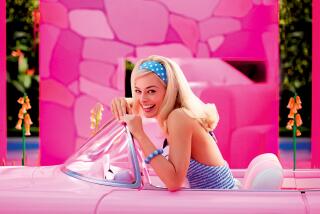An Impressionable World: Self-Images of Young Girls
- Share via
It only underscored the theme of a Girls Inc.-sponsored seminar Tuesday--exploring the sort of media stereotypes that help shape young girls’ images--that the walls happened to be lined with costume and production design pictures from “Cinderella,” including glittering ball gowns.
Held at the Museum of Television & Radio in Beverly Hills, the event sought to strip away some of that fantasy--bringing together representatives of the entertainment industry, members of the New York-based organization (formerly known as the Girls Clubs of America) and girls from the group’s Carpinteria chapter to consider how the media can support educational efforts to help girls improve their self-images.
Much of the discussion focused on appearance and unrealistic expectations that might be fostered by what girls see in movies, television and even toy stores, down to whether kids would buy Barbie if she sported more mundane dimensions.
Tracey Lawrence, senior vice president and general manager of the Fox Family Channel, alluded to how such merchandising considerations intrude even on the process of creating TV programs, saying she has been told in regard to cartoon characters, “ ‘She’s too ugly. Girls won’t buy the doll.’ I’ve been in far too many conversations like that.”
Lawrence later noted that girls receive too many conflicting images, among them pop star Britney Spears, who is “dolled up to please much older men, which I would argue is not a great role model.”
Actress Amy Aquino, who appears on the WB network series “Felicity,” also suggested there is need for greater caution when producers begin moving teen characters into sexual situations.
“Once you throw the sexuality in, you’re making this girl, whether you like it or not, a sexual object,” she said.
Mary Grabiak, 12, from Carpinteria, told the panelists she feels Saturday-morning programs often understand these issues better than some prime-time shows. Citing the WB’s “7th Heaven,” she complained that otherwise strong girl characters are often made to behave foolishly when boys enter the picture. “We get the point: Girls do like guys,” she said.
Sue Rose, producer of the ABC animated series “Pepper Ann,” noted that children’s programs aimed at girls labor against a “very misguided myth” that boys will not tune in shows that feature girl characters. Such research has limited the number of series focusing on girls, who are generally perceived to be more willing to watch when boys are cast in central roles.
“Every single step of the way you have to be vigilant . . . all the way down to the toys and advertisers” within the programs, Rose said.
Winifred White Neisser, senior vice president of movies and miniseries at Columbia TriStar Television and a one-time children’s programming executive, pointed to the photos and drawings of Cinderella as a sign of the ingrained challenges producers and marketers of entertainment face.
“You have to look at the history of storytelling,” she noted. “There are a lot of stereotypes to overcome.”
Still, she added that progress has been made in breaking from conventional standards of beauty, including an upcoming TV movie that casts Camryn Manheim--the overweight star of ABC’s “The Practice”--as a romantic lead.
Girls Inc. launched a “Girls’ Rights” initiative in March and is soliciting support from entertainment companies for a public-service campaign to disseminate those messages, which include resisting gender stereotypes and getting girls to “accept and appreciate their bodies.”
More to Read
The biggest entertainment stories
Get our big stories about Hollywood, film, television, music, arts, culture and more right in your inbox as soon as they publish.
You may occasionally receive promotional content from the Los Angeles Times.










